
In the dynamic world of live performances, the purity and clarity of sound play an integral role in capturing and retaining audience attention. One of the prime sound concerns at live concerts, speeches or theatre performances is the troublesome phenomenon known as audio feedback. This displeasing sound, often akin to a sharp, high-pitched squeal or a deep rumbling echo, derives from a loop within the sound system’s signal chain leading to sound amplification. While seemingly complex to grasp, understanding the nature of feedback, its causes, and the science behind its occurrence is key to effective management.
Surviving the feedback menace involves smart handling of sound equipment and keenification of audio settings. This necessitates an in-depth knowledge of sound propagation, effective placement of microphones, speakers, and monitors to minimize feedback, and identification of the potential ‘feedback zones’ where the menace is most likely to occur during live performances. Additionally, the essence of a well-conducted soundcheck and precise adjustment of equipment settings, such as volume, equalizers, and gains to control feedback-provoking frequencies, cannot be understated.
Understanding Audio Feedback
Title: Deconstructing Audio Feedback: The Phantom Menace of Live Performances
For all the tech enthusiasts out there, especially those dabbling in the audio department, you’ve certainly encountered the undersung antagonist of acoustic performances—audio feedback. But what is audio feedback, and why does it find such affinity with live shows?
Audio feedback or loop, is an auditory phenomenon that happens when a sound loop exists between an audio input, say a microphone, and an audio output, like a speaker, creating a sound frequency that continuously amplifies itself. It often manifests as an annoying screech or howl at live events, which can quickly ruin a performance.
Imagine a wild beast waking up from slumber, stirring slowly at first, then escalating into a loud roar—yes, that’s audio feedback in a nutshell. Tech geeks will recognize the technical term, ‘Larsen Effect’, named after Danish scientist Soren Larsen, who first dissected this sonic beast.
So why does it occur more frequently during live performances? There are various reasons.
- First on the list is the proximity of the microphone to the speakers. When they’re close together, the sounds from the speaker easily reach the microphone, causing that repetitive, escalating loop—a result of the amplified sound being re-amplified over and over again.
- Another contributing factor is the orientation of the mic relative to the speakers. If an open microphone points directly at a speaker, the chances of audio feedback skyrocket, particularly if the speaker is outputting the same frequencies as the ones being picked up by the microphone. In simple terms, it’s like these audio devices are caught up in an endless cycle, amplifying and reamplifying the same sound, thus birthing the unwanted wailing noise.
- The third element stirring the audio feedback pot is the room’s acoustics. Surfaces that are hard and flat—think walls, ceilings,—are prime candidates for bouncing sound around, making feedback more likely. It’s a bit like a pinball machine. The sound waves ricochet off surfaces, creating multiple opportunities for them to be picked up again by the microphone.
- Last but not least, poor quality sound equipment or improper equalization configuration can also incite audio feedback. Inferior gear or incorrectly adjusted equipment—too much gain or volume, for instance—can cause imbalances in certain frequencies, nudging audio feedback into existence.
Mitigating audio feedback, then, is about curtailing these conditions: maintaining safe distances between mics and speakers, orienting mics away from speakers, managing room acoustics, and optimizing audio equipment. Remember, in the world of live audio, preventing feedback is a masterstroke that separates the amateurs from the pros.
Being armed with this understanding, every tech enthusiast can take a step closer to delivering flawless sound in real-time situations. No magic, no jargon, just the beautiful logic of technology applied.

Proper Sound Equipment Placement
Proper placement of sound equipment is a critical factor in reducing audio feedback at live performances. Ensuring the speakers and microphones are optimally positioned can substantially minimize the chances of the dreaded feedback occurring.
An unfortunate reality of live performances, that’s all too often overlooked, is the implications related to the directionality of speakers and microphones. In essence, the direction towards which these devices emit or capture sound significantly influences the likelihood of audio feedback. The microphone, direly sensitive, perceives vibrations in the surrounding air as sound. Speakers, on the other hand, are sound-producing devices that generate vibrations in the air.
For the speakers, the directionality is primarily in the frontal region and, to a lesser extent, on the sides. Theoretically, the back of the speakers should be free from any significant sound projection. However, due to various factors such as speaker design, room acoustics, and reflected sound, some sound might still escape from the back. It’s a good practice to place speakers slightly ahead of the performer(s) and audience, and orient them outwards from the stage.
Now let’s consider the microphones. Microphones, especially the commonly used directional types (cardioid, supercardioid, or hypercardioid), capture sound predominantly from the front and sides. The level of sound capture (sensitivity) reduces as we move towards the back. Therefore, angling the microphone at an optimal distance and direction relative to the speakers proves crucial. Simply put, the microphone should be oriented in such a way that it is least sensitive towards the speakers.
By ensuring that the microphone is least sensitive to the speakers and the speakers are not directing sound towards the microphones, the chances of audio feedback are reduced dramatically.
On another note, stage monitors play a unique role. For the performers to hear themselves, these speakers are angled directly towards them, often very close to the microphones. This proximity might increase the chances of audio feedback. Therefore, the placement of stage monitors needs to be carefully considered as well. Personal in-ear monitors are a great alternative for reducing feedback, as they directly feed the sound to the performer, virtually eliminating the feedback path.
Lastlt, technology is our friend when it comes to managing audio feedback. While manual tuning, understanding the directionality of your gear, and avoiding feedback-enabling positioning are important, no technical enthusiast would ever turn down the opportunity to automate and simplify the process. Software and hardware tools are available that automatically monitor and adjust frequency levels to mitigate audio feedback, making the process of delivering perfect audio at live performances that much easier.
Audio feedback occurrence is not inevitable. With knowledge, appropriate arrangement, and leveraging technology, audio feedback at live performances can be reduced, leading to quality sound experience for the performers and listeners alike. Embracing this analytical and systematic approach will ensure an optimal sound environment for any live setup, free from the menace of audio feedback. Conclusively, efficiency in the battlefield of live audio is acquired through strategic preparation and high-quality equipment – not just hopeful last-minute adjustments.

Sound Check and Equipment Adjustment
After now understanding the basics of audio feedback, the ‘Larsen Effect’, and its impact on live performances, it’s time to plunge into the practical solutions to mitigate these effects, starting with sound checks and equipment adjustments.
Carrying out a rigorous sound check is essential for achieving a distortion-free and feedback-less live performance. Sound checks allow audio technicians to assess individual inputs and outputs, adjusting levels to ensure the best sound quality. Each performer’s microphone, for example, would be tested one-by-one and adjusted to ensure minimal feedback.
Since feedback typically occurs when certain frequencies are amplified excessively, identifying these frequencies during the sound check can help reduce feedback. You can do this using an Equalizer (EQ). The sound technician can tweak these frequencies to prevent them from triggering feedback during the performance. This process, known as “ringing out” the system, may seem tedious but is integral to avoiding audio feedback.
Equipment adjustment is another crucial step in preventing feedback during live performances. This goes beyond simply adjusting the volume or balance of various channels. It includes tweaking the gain structure of the sound system, ensuring the speakers and the microphones are correctly oriented, and adjusting the system’s Equalization (EQ).
For instance, it’s important to carefully control the total system gain to avoid getting the system to a point where feedback occurs. This may involve lowering the volume of the speaker system or reducing the microphone’s sensitivity.
When it comes to the directionality of speakers and microphones, understanding their polar patterns can aid in avoiding feedback. Most microphones are designed to pick up sound from certain directions. Knowing this, performers can position and angle their microphones to pick up their voice but reject sound coming from the speaker systems.
Similarly, speakers should be oriented such that their sound projection is distinct from the direction of your microphones. Placing speakers in front of, instead of behind, the performers often helps achieve this.
Here’s where stage monitors come into play. Typically positioned to face performers, these have the potential to create a different kind of feedback loop if not managed properly. One solution is to use in-ear monitors (IEMs), which reduces the overall stage volume, thereby decreasing the likelihood of audio feedback.
Deploying technological tools becomes a key ally for sound technicians. Various hardware and software tools, such as feedback eliminators, can automatically identify and tame those feedback-prone frequencies. Digital mixers can even store settings from previous successful sound checks, easing the adjustments needed for future performances.
Taking a systematic approach, therefore, is the key to rope in audio feedback. Dial in each component of the system – from initial capture (microphones) through signal processing and amplification, to final delivery (speakers) – meticulously tweaking and optimizing each stage. Don’t disregard the importance of strategic preparation and reliance on quality equipment to avoid this intense battle with feedback and aid in creating a phenomenal sound environment for live performances. Remember, at its core, however technical the process, it is a lot about your ear’s discernment and understanding of sound. With time, experience, and commitment, the battle with feedback is all but won. Let’s turn the tables on feedback, shall we?

Mastering the art of feedback control is no small feat; it requires dedication, understanding, and careful application of the principles discussed here. Regardless of the size or nature of a live performance, the shattering effect of feedback can be significantly diminished, or even eliminated completely, by understanding the physics behind its occurrence, positioning the sound equipment correctly, executing a meticulous sound check, and adjusting equipment settings diligently. Disruptive feedback need not put a damper on live performances. With consistent commitment to these strategies, one can ensure clearer, cleaner sound that enhances the overall quality of a live event and ultimately, captivates the audience.

Comments.
Currently there are no comments related to this article. You have a special honor to be the first commenter. Thanks!